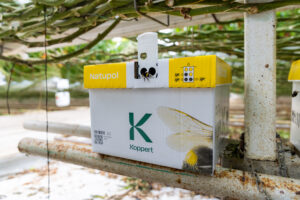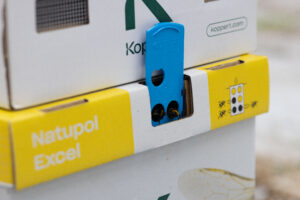Applying 5G mobile communications technology in a closed environment such as a greenhouse is relatively new. Numerous studies have examined the effects of electromagnetic fields on flora and fauna. Yet, the novel frequencies used by 5G systems are higher than those used by 2G-4G networks. They potentially have a greater impact on smaller organisms, such as plants and pollinators. The aim of this project is therefore to determine whether a 5G network has any effect on the growth of plants or on the behavior of pollinators in a greenhouse.
Duration
September 2024 – December 2025
Partners (TU Delft)
Do IoT Fieldlab, TU Delft, RoboHouse
Partners (other)
The Hague University of Applied Sciences, Tomatoworld, Koppert, TNO, MCS
Wireless connectivity is key to develop future applications in the greenhouse. At Tomatoworld, a private 5G network enables dedicated 5G greenhouse experiments. Wireless communication in this network takes place through the emissions of electromagnetic fields (EMFs) at a frequency of about 3.8 GHz. We fully want to understand the potential effects of these EMFs on the greenhouse ecosystem. The Smart Sensor Systems research group of The Hague University of Applied Sciences developed specific 5G EMF sensors. These sensors continuously measure the EMF levels at distributed locations and over the course of multiple growing seasons.

Combined data
The measurement data are combined with data on the behaviour of bumblebees. We study this behaviour with a variety of techniques: counters at the bumblebee hive entrances, microphones near flowers and cameras covering large parts of the greenhouse. The third objective of this research is to discover if the plants themselves, as they keep growing, eventually form an obstacle to the transmission of the 5G signal.
Effect of 5G network
Finally, all the data collected on EMF levels, bumblebee behaviour, plant growth and quality of the 5G signal, will be analysed to assess the effect of the 5G network on the growth of plants and the behavior of the pollinators. For a complete picture of the applicability of 5G in a greenhouse, the quality of the 5G signal is assessed at different stages of plant growth, to determine the ideal infrastructure for optimal data transmission. This project combines the in depth expertise of connectivity researchers at The Hague University of Applied Sciences, knowledge on pollinator behaviour experts from Koppert, a leading company in biological crop solutions, and knowhow from crop experts at Tomatoworld.


Three phases
The approach consists of three phases. In the first step, EMF sensors are installed throughout the greenhouse and integrated within the infrastructure. The locations vary in high and low assumed EMF levels. In the second step, three methods for bumblebee behaviour monitoring are developed into sensors: a hive counter using an infrared light, a microphone near tomato flowers to listen to bumblebee buzzes, and a camera to detect bumblebee flight patterns. The third step is to share the results to the scientific community in an open-access journal.

This research is co-financed by the Swiss Research Foundation for Electricity and Mobile Communication (FSM) (project number A2024-05, 2025-2027).
